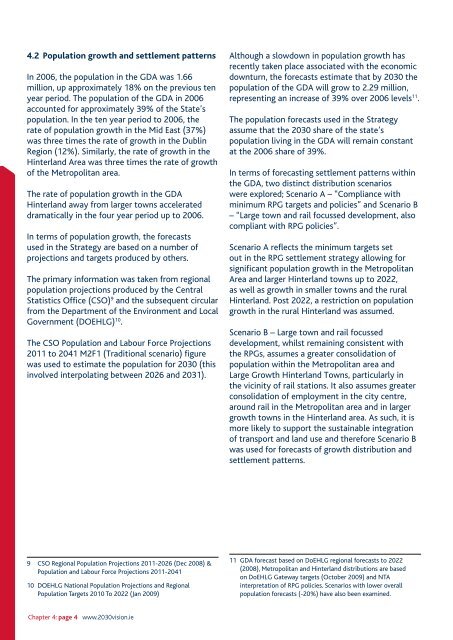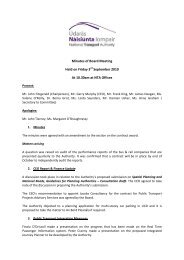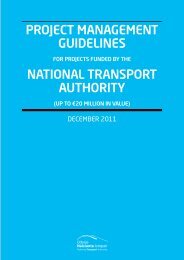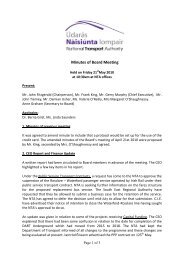Greater Dublin Area Draft Transport Strategy 2011-2030
Greater Dublin Area Draft Transport Strategy 2011-2030
Greater Dublin Area Draft Transport Strategy 2011-2030
- No tags were found...
You also want an ePaper? Increase the reach of your titles
YUMPU automatically turns print PDFs into web optimized ePapers that Google loves.
4.2 Population growth and settlement patternsIn 2006, the population in the GDA was 1.66million, up approximately 18% on the previous tenyear period. The population of the GDA in 2006accounted for approximately 39% of the State’spopulation. In the ten year period to 2006, therate of population growth in the Mid East (37%)was three times the rate of growth in the <strong>Dublin</strong>Region (12%). Similarly, the rate of growth in theHinterland <strong>Area</strong> was three times the rate of growthof the Metropolitan area.The rate of population growth in the GDAHinterland away from larger towns accelerateddramatically in the four year period up to 2006.In terms of population growth, the forecastsused in the <strong>Strategy</strong> are based on a number ofprojections and targets produced by others.The primary information was taken from regionalpopulation projections produced by the CentralStatistics Office (CSO) 9 and the subsequent circularfrom the Department of the Environment and LocalGovernment (DOEHLG) 10 .The CSO Population and Labour Force Projections<strong>2011</strong> to 2041 M2F1 (Traditional scenario) figurewas used to estimate the population for <strong>2030</strong> (thisinvolved interpolating between 2026 and 2031).Although a slowdown in population growth hasrecently taken place associated with the economicdownturn, the forecasts estimate that by <strong>2030</strong> thepopulation of the GDA will grow to 2.29 million,representing an increase of 39% over 2006 levels 11 .The population forecasts used in the <strong>Strategy</strong>assume that the <strong>2030</strong> share of the state’spopulation living in the GDA will remain constantat the 2006 share of 39%.In terms of forecasting settlement patterns withinthe GDA, two distinct distribution scenarioswere explored; Scenario A – “Compliance withminimum RPG targets and policies” and Scenario B– “Large town and rail focussed development, alsocompliant with RPG policies”.Scenario A reflects the minimum targets setout in the RPG settlement strategy allowing forsignificant population growth in the Metropolitan<strong>Area</strong> and larger Hinterland towns up to 2022,as well as growth in smaller towns and the ruralHinterland. Post 2022, a restriction on populationgrowth in the rural Hinterland was assumed.Scenario B – Large town and rail focusseddevelopment, whilst remaining consistent withthe RPGs, assumes a greater consolidation ofpopulation within the Metropolitan area andLarge Growth Hinterland Towns, particularly inthe vicinity of rail stations. It also assumes greaterconsolidation of employment in the city centre,around rail in the Metropolitan area and in largergrowth towns in the Hinterland area. As such, it ismore likely to support the sustainable integrationof transport and land use and therefore Scenario Bwas used for forecasts of growth distribution andsettlement patterns.9 CSO Regional Population Projections <strong>2011</strong>-2026 (Dec 2008) &Population and Labour Force Projections <strong>2011</strong>-204110 DOEHLG National Population Projections and RegionalPopulation Targets 2010 To 2022 (Jan 2009)11 GDA forecast based on DoEHLG regional forecasts to 2022(2008), Metropolitan and Hinterland distributions are basedon DoEHLG Gateway targets (October 2009) and NTAinterpretation of RPG policies. Scenarios with lower overallpopulation forecasts (-20%) have also been examined.Chapter 4: page 4 www.<strong>2030</strong>vision.ie
















